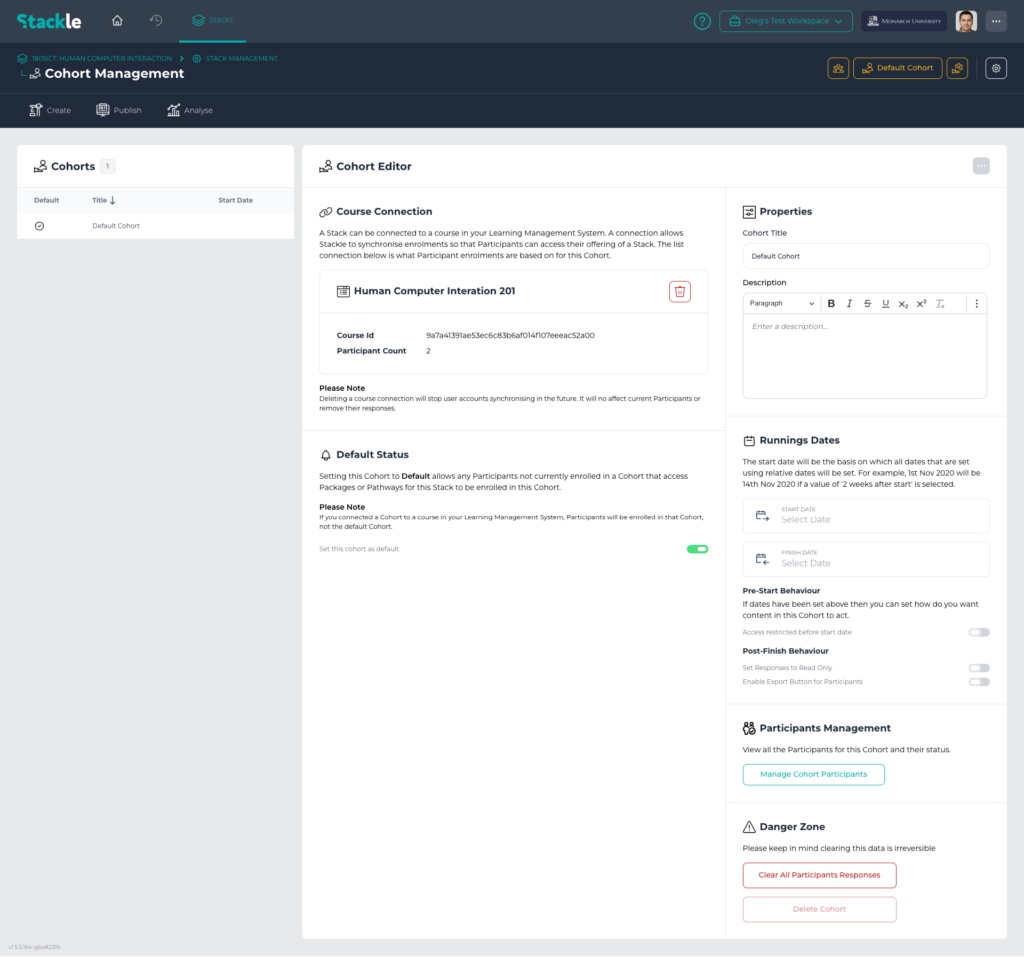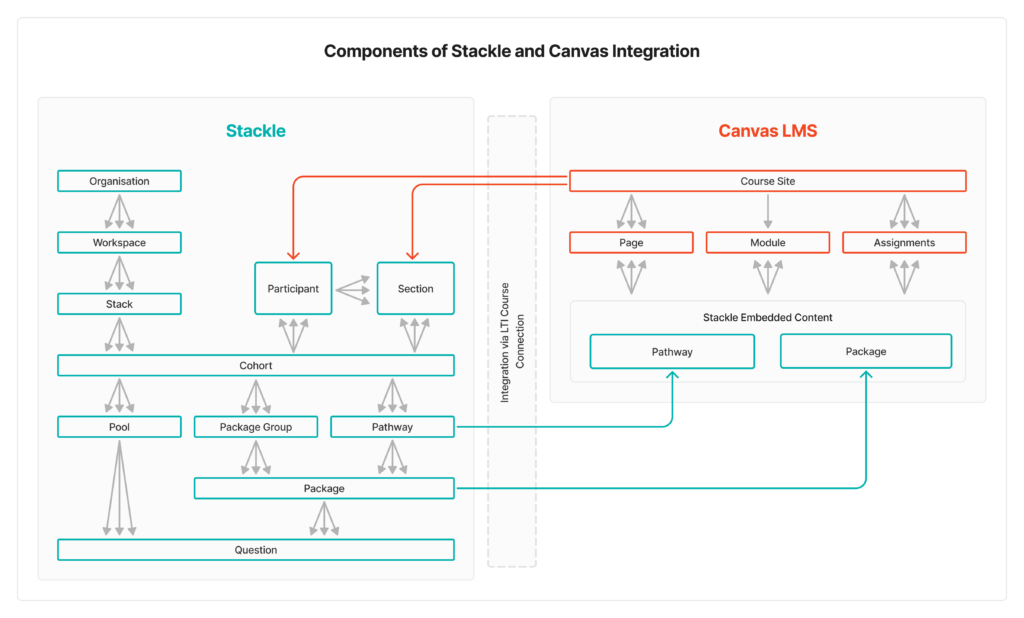Overview #
Cohorts offer a method for dividing a Stack into smaller, distinct sections, each containing its own:
- Participants
- Course Connections
- Pools
- Questions
- Packages
- Pathways

When creating Cohorts, you have the option to duplicate a previous version with its content or start anew, while preserving the Participants and their responses in the active cohort. This flexibility allows you to carry the contents of a cohort forward from one offering to another seamlessly.
With Stackle’s mapping feature, any packages or pathways embedded in a Learning Management System are linked to their respective cohorts, ensuring a well-organized and efficient learning experience that requires no intervention on the part of an author. Embed codes and links continue to work and changes that are made to one Cohort don’t affect the experience of the others.
Where do Cohorts fit in Stackle? #
Cohorts sit directly under a Stack. There can be many Cohorts within a Stack.

How can we use Cohorts? #
In Stackle, Cohorts can provide several advantages, including:
- Segmenting content for multiple offerings: By dividing content into separate Cohorts, you can create parallel course offerings targeting distinct student groups or timelines. This allows you to cater to diverse learning preferences and schedules, accommodating both full-time and part-time students.
- Designing diverse course formats: Cohorts enable you to structure different versions of a course, such as a six-week intensive or a twelve-week standard format. This flexibility empowers you to address various learning styles, pacing preferences, and time commitments of your students, providing them with a more personalized and effective learning experience.
- Generating unique question sets tailored to different student levels: With Cohorts, you can create customized question sets that address the specific needs of undergraduate and postgraduate students. This approach ensures that your assessments are better aligned with your learners’ backgrounds and skill levels, promoting more accurate evaluation and fostering a deeper understanding of the subject matter.
- Developing varying versions suitable for deployment across different platforms: Cohorts allow you to adapt course content for multiple platforms, such as online, in-person, or blended learning environments. This flexibility ensures that your course materials are optimized for different delivery methods, providing a seamless and engaging experience for your students, regardless of their learning environment.
- Customizing content for learners with different language preferences: Cohorts can be used to create versions of a course tailored to specific language groups, ensuring that content is accessible and comprehensible to a wider range of learners.
- Addressing the needs of learners with varying abilities: By creating Cohorts that focus on different levels of difficulty, you can better cater to the diverse abilities and learning needs of your students. This approach enables you to provide appropriate challenges for advanced learners while offering more support to those who may struggle with the material.
- Creating role-specific training materials: For professional training or workplace settings, you can use cohorts to develop content tailored to different job roles or departments. This targeted approach ensures that each group receives the most relevant and useful information for their specific responsibilities.
- Adapting content for cultural or regional differences: Cohorts can be used to create course materials that are sensitive to and reflective of specific cultural or regional contexts. This approach fosters a more inclusive learning environment and helps learners better connect with the content.
- Implementing A/B testing for course optimization: By using Cohorts to create and compare different versions of a course or specific components, you can gather valuable data on what works best for your students. This data-driven approach allows you to continuously refine and improve your course materials based on actual student outcomes and feedback.
These features allow you to efficiently manage and customize your course content to meet the specific needs of your students and platforms.
How Mapping Works with Cohorts #
The power of Stackle Cohorts lies within the ability to have the content duplicated within an instance but still correctly map from a consistent URL. If we take the following example:

For the 1805ICT course, a new Stack has been set up. A cohort called “Cohort A” has been created within this Stack by someone who’s organizing the content.
A link has been established between “Course A – 2022” and “Cohort A”. The team responsible for creating content has added questions and a package called “1st Survey” to the course.
Now, in 2023, a new version of the 1805ICT course is being offered. The course has been duplicated and renamed as “Course B”. In Stackle, a new cohort, “Cohort B,” is created based on copying “Cohort A,” and the questions and survey have been copied over.
A connection is made between “Course B – 2023” and “Cohort B.” Participants who took part in “Course A – 2022” will see “Cohort A” content, while those in “Course B – 2023” will see “Cohort B” content.
This whole process only takes a few clicks to complete and has provided numerous benefits to the authoring team, the institution, and the participants. Plus, there’s no need to update the links to the package in the course, as they remain the same.
The Benefits of Cohort and Course Connections #
Cohort and Course connections offer numerous advantages in an educational context. These benefits include:
- Maintaining the historical accuracy of a Participant’s experience during their studies.
- Utilizing cohort-based analytics to:
- Justify modifications to course design.
- Provide insights into a course’s previous offerings compared to others.
- Allowing updates to be made without impacting other cohorts.
- Creating a backup of a course offering, enabling older offerings to be copied forward if necessary.
These features ensure that course content can be efficiently managed, analyzed, and improved over time while preserving the integrity of each student’s educational experience.